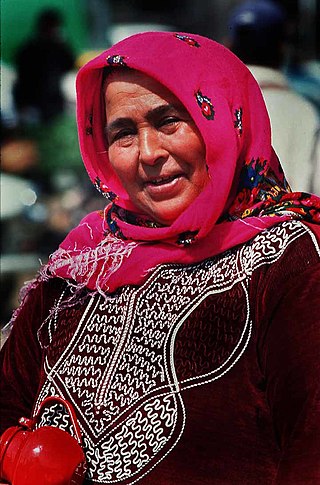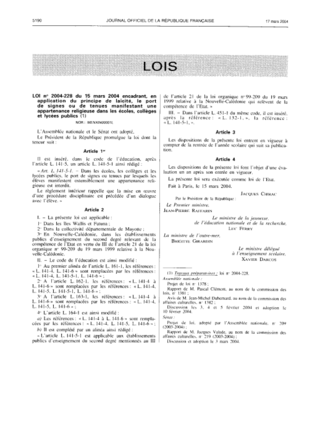
In modern usage, hijab generally refers to various headcoverings worn by Muslim women. While a hijab can come in many forms, it often specifically refers to a headscarf, wrapped around the head and neck, covering the hair, neck, and ears but leaving the face visible. The use of the hijab has been on the rise worldwide since the 1970s and is viewed by many Muslims as expressing modesty and faith. There is a consensus among Islamic religious scholars that covering the head is either required or preferred, though some Muslim scholars and activists argue that it is not required. In practice, most Muslim women do choose to wear it.

Whilst the House of Lords of the United Kingdom is the upper chamber of Parliament and has government ministers, for many centuries it had a judicial function. It functioned as a court of first instance for the trials of peers and for impeachments, and as a court of last resort in the United Kingdom and prior, the Kingdom of Great Britain and the Kingdom of England.

Court dress comprises the style of clothes and other attire prescribed for members of courts of law. Depending on the country and jurisdiction's traditions, members of the court may wear formal robes, gowns, collars, or wigs. Within a certain country and court setting, there may be many times when the full formal dress is not used. Examples in the UK include many courts and tribunals including the Supreme Court of the United Kingdom, and sometimes trials involving children.

The French law on secularity and conspicuous religious symbols in schools bans wearing conspicuous religious symbols in French public primary and secondary schools. The law is an amendment to the French Code of Education that expands principles founded in existing French law, especially the constitutional requirement of laïcité: the separation of state and religious activities.

Mohd. Ahmad Khan v. Shah Bano Begum [1985 (1) SCALE 767 = 1985 (3) SCR 844 = 1985 (2) SCC 556 = AIR 1985 SC 945], commonly referred to as the Shah Bano case, was a controversial maintenance lawsuit in India, in which the Supreme Court delivered a judgment favouring maintenance given to an aggrieved divorced Muslim woman. Then the Congress government enacted a law with its most controversial aspect being the right to maintenance for the period of iddat after the divorce, and shifting the onus of maintaining her to her relatives or the Waqf Board. It was seen as discriminatory as it denied right to basic maintenance available to Muslim women under secular law.

The term jilbāb refers to any long and loose-fit coat or outer garment worn by some Muslim women. Wearers believe that this definition of jilbāb fulfills the Quranic choice for a hijab. The jilbāb is also known as chador by Persian speakers in Iran and Afghanistan. The modern jilbāb covers the entire body. Some women will also cover the hands with gloves and the face along with a niqāb. In recent years, a short visor is often included to protect the face from the tropical sun.
Denbigh High School is an academy school in Luton, Bedfordshire, England. Colin Townsend was Headteacher, following Dame Yasmin Bevan's retirement as Executive Principal and Headteacher at the end of 2014. Donna Neely-Hayes as acting Headteacher, followed Townsend's departure to University of Birmingham School in late 2018.
John Anson Brightman, Baron Brightman, PC was a British barrister and judge who served as a law lord between 1982 and 1986.

The judiciaries of the United Kingdom are the separate judiciaries of the three legal systems in England and Wales, Northern Ireland and Scotland. The judges of the Supreme Court of the United Kingdom, the Special Immigration Appeals Commission, Employment Tribunals, Employment Appeal Tribunal and the UK tribunals system do have a United Kingdom–wide jurisdiction but judgments only apply directly to the jurisdiction from which a case originates as the same case points and principles do not inevitably apply in the other jurisdictions. In employment law, employment tribunals and the Employment Appeal Tribunal have jurisdiction in the whole of Great Britain.
Punjabi culture grew out of the settlements along the five rivers which served as an important route to the Near East as early as the ancient Indus Valley civilization, dating back to 3000 BCE. Agriculture has been the major economic feature of the Punjab and has therefore formed the foundation of Punjabi culture, with one's social status being determined by landownership. The Punjab emerged as an important agricultural region, especially following the Green Revolution during the mid-1960's to the mid-1970's, has been described as the "breadbasket of both India and Pakistan". Besides being known for agriculture and trade, the Punjab is also a region that over the centuries has experienced many foreign invasions and consequently has a long-standing history of warfare, as the Punjab is situated on the principal route of invasions through the northwestern frontier of the Indian subcontinent, which promoted to adopt a lifestyle that entailed engaging in warfare to protect the land. Warrior culture typically elevates the value of the community's honour (izzat), which is highly esteemed by Punjabis.

Pepper v Hart [1992] UKHL 3, is a landmark decision of the House of Lords on the use of legislative history in statutory interpretation. The court established the principle that when primary legislation is ambiguous then, in certain circumstances, the court may refer to statements made in the House of Commons or House of Lords in an attempt to interpret the meaning of the legislation. Before this ruling, such an action would have been seen as a breach of parliamentary privilege.
Hijab and burka controversies in Europe revolve around the variety of headdresses worn by Muslim women, which have become prominent symbols of the presence of Islam in especially Western Europe. In several countries, the adherence to hijab has led to political controversies and proposals for a legal partial or full ban in some or all circumstances. Some countries already have laws banning the wearing of masks in public, which can be applied to veils that conceal the face. Other countries are debating similar legislation, or have more limited prohibitions. Some of them apply only to face-covering clothing such as the burqa, boushiya, or niqab; some apply to any clothing with an Islamic religious symbolism such as the khimar, a type of headscarf. The issue has different names in different countries, and "the veil" or hijab may be used as general terms for the debate, representing more than just the veil itself, or the concept of modesty embodied in hijab.

The Taqiyah, also known as tagiyah or araqchin is a short, rounded skullcap. It is often worn for cultural or religious purposes; for example, some Muslims believe that the Islamic prophet Muhammad used to keep his head covered, therefore making it mustahabb. Muslim men often wear them during the daily prayers.

In modern usage, ḥijāb (hijab) generally refers to the various headcoverings frequently worn by Muslim women. Wearing hijab is mandatory in some Muslim countries, and optional or restricted in other majority Muslim and majority non-Muslim countries. In the Indonesian Aceh province, Muslim women are required to wear the hijab and all women are required to do so regardless of religion in Iran and Afghanistan. In countries such as Saudi Arabia, the hijab is not required. Meanwhile, in Gaza, Palestinian school officials have voted to require young girls to wear hijab, while Palestinian jihadists belonging to the Unified Leadership (UNLU) have rejected a hijab policy for women. They have also targeted those who seek to impose the hijab.

Article 15 of the Constitution of the Republic of Singapore guarantees freedom of religion in Singapore. Specifically, Article 15(1) states: "Every person has the right to profess and practise his religion and to propagate it."

Shalwar kameez is a traditional combination dress worn by women, and in some regions by men, in South Asia, and Central Asia.

McFarlane v Relate Avon Ltd[2010] EWCA Civ 880; [2010] IRLR 872; 29 BHRC 249 was an application in the Court of Appeal of England and Wales for permission to appeal against a decision of the Employment Appeal Tribunal, that a relationship counsellor dismissed for refusing to counsel same sex couples on sexual matters because of his Christian beliefs did not suffer discrimination under the Employment Equality Regulations 2003. The application was heard by Lord Justice Laws, who issued his decision on 29 April 2010 refusing the application.
The failure of a public authority to take into account relevant considerations and the taking of irrelevant ones into account are grounds of judicial review in Singapore administrative law. They are regarded as forms of illegality.

In the ancient Punjab region, people wore cotton clothing. Both men and women wore knee-length tops. A scarf was worn over the tops which would be draped over the left shoulder and under the right. A large sheet would be further draped over one shoulder which would hang loose towards the knees. Both male and female wore a dhoti around the waist. Modern Punjabi dress has retained this outfit but over its long history has added other forms of dress.

Begum v Home Secretary [2021] UKSC 7 is the short name of three closely connected proceedings considered together in the Supreme Court of the United Kingdom, R v Special Immigration Appeals Commission; R v Secretary of State for the Home Department; and Begum v Secretary of State for the Home Department, concerning Shamima Begum, a woman born in the United Kingdom who at the age of 15 travelled to Syria to join the Islamic State of Iraq and the Levant (ISIS). Her intention to return to England in 2019 resulted in a public debate about the handling of returning jihadists.












